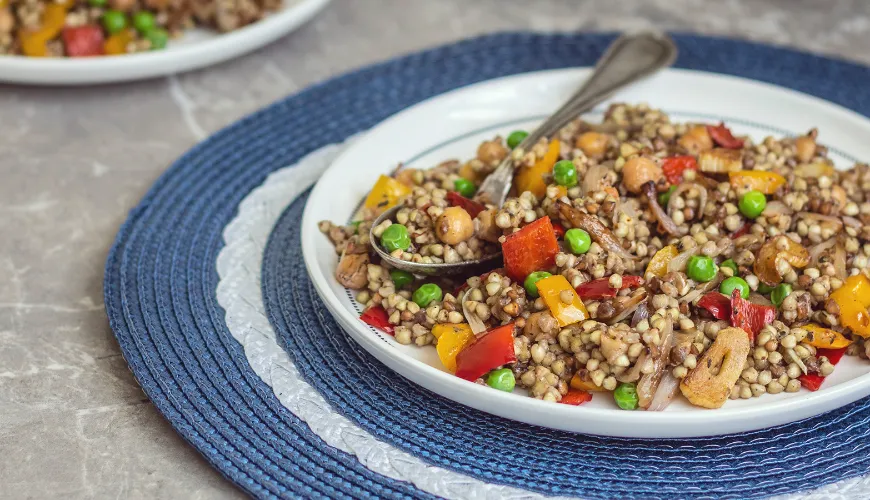
How to Cook Buckwheat and Get the Most Health Benefits From It?

How to Cook Buckwheat?
Although often mistakenly categorized as a grain, buckwheat is actually a pseudocereal. This means that botanically it does not belong to classic cereals, but due to its use and nutritional values, it is similarly used. Buckwheat originates from Asia, from where it spread to Europe, and today it is making its way back onto the plates of many households aware of its health benefits. Nowadays, buckwheat has become a popular part of a healthy diet, not only because it is naturally gluten-free but also because of its unique composition full of vitamins and minerals.
What is buckwheat and why is it so healthy?
Buckwheat is rich in proteins and has a high fiber content, which supports digestion and helps maintain stable blood sugar levels. It contains a range of vitamins, especially B vitamins (B1, B2, and niacin), which support metabolism and the nervous system. Among the minerals, buckwheat provides iron, magnesium, copper, and manganese, which is important for bone health and the immune system.
An important component of buckwheat is the antioxidant rutin, known for its beneficial effects on the cardiovascular system. Rutin strengthens blood vessels and may help lower blood pressure. For those interested in inflammation prevention, buckwheat is an excellent choice, as its antioxidant components help the body fight free radicals.
Additionally, buckwheat is naturally gluten-free, making it an ideal food for people with gluten intolerance or celiac disease. This feature makes it an alternative to common side dishes like wheat or rye without having to compromise on taste or texture.
How to cook buckwheat and what to consider when cooking
Proper preparation of buckwheat is the key to achieving a delicious taste and ideal consistency. So how do you cook buckwheat to make it tasty and have the necessary structure?
-
Rinsing: Before cooking, it's good to thoroughly rinse buckwheat under running cold water. This removes any dust impurities and substances that may cause a slightly bitter taste. Some people also scald it briefly with hot water to remove even more bitterness and achieve a milder flavor.
-
Cooking: Pour buckwheat into a pot and cover it with boiling water. The ideal ratio is one part buckwheat to two parts water. Cook the buckwheat on a low heat for approximately 10 to 15 minutes until it absorbs all the water. There's no need to stir buckwheat during cooking, just check that it isn't boiling too intensely.
-
Steaming: An alternative preparation method is steaming. Pour boiling water over the buckwheat, cover with a lid, and let it sit for about 20 minutes. This way, the buckwheat prepares almost by itself and retains more nutrients since it is cooked for a very short time.
-
Seasoning: Cooked buckwheat has a mild, nutty flavor that you can easily enhance with salt, herbs, or a bit of olive oil. Buckwheat is versatile and pairs well with various ingredient combinations.
Buckwheat uses in the kitchen
Buckwheat can be used in many ways, making it an invaluable part of a healthy kitchen. Once you master the basic method of cooking buckwheat, you can vary and use it in diverse recipes.
-
Side dish: Cooked buckwheat can be served as a side dish to meat, fish, or vegetable dishes. It is a great alternative to potatoes, rice, or pasta.
-
Salads: Buckwheat fits excellently into salads, where you can combine it with vegetables, cheese, nuts, and olive oil. Just let it cool and add other ingredients – the result is a hearty and healthy salad.
-
Porridge: Especially in the winter months, you can prepare buckwheat porridge for breakfast. Cook the buckwheat a bit longer until it becomes completely soft, then mix it with honey, nuts, fruits, or cinnamon.
-
Gluten-free baking: Buckwheat is also popular for gluten-free baking. From buckwheat flour, you can make pancakes, crepes, or various cakes, which will be appreciated by those with gluten sensitivity.
Buckwheat is not only delicious but also an exceptionally healthy food worth including in your diet. Whether you decide to use it as a side dish or a main course, you'll find that its mild taste and rich nutritional values are worth it. Try it and experiment with different recipes – it will enrich your menu and bring many benefits to your health.

